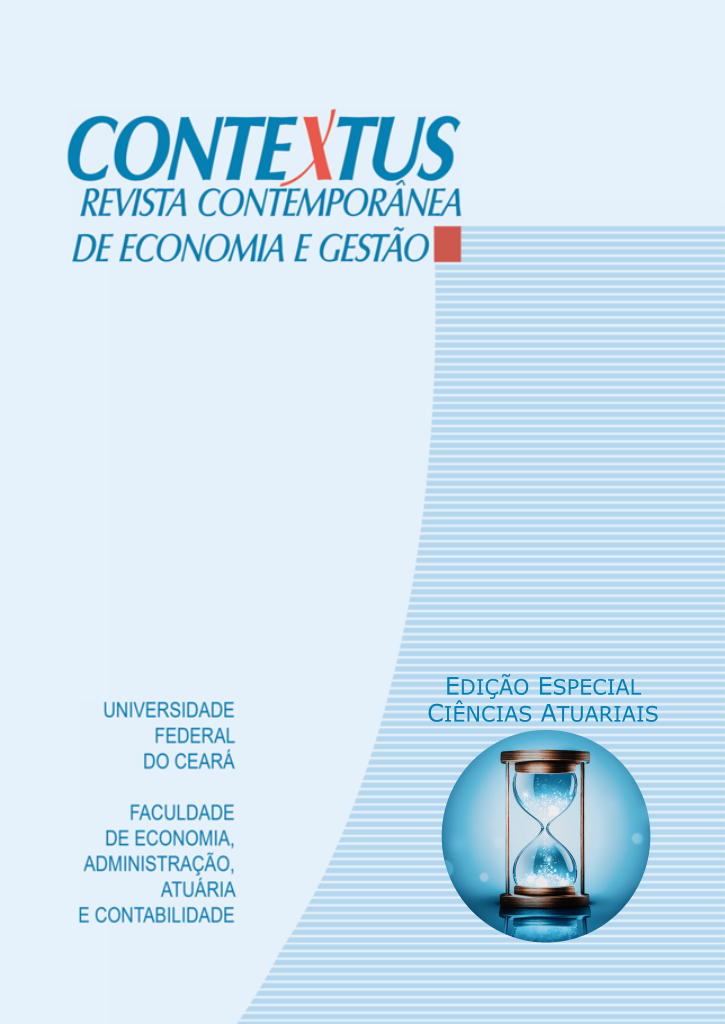The simplex regression model as a methodology of actuarial analysis
DOI:
https://doi.org/10.19094/contextus.2023.83379Keywords:
regression, simplex, methodology, actuarial, analysisAbstract
The risk management business evolves rapidly, so actuaries are faced with the need for new analysis methodologies. However, the use of incorrect methodologies for actuarial modeling can have serious implications for strategic decision making. This study aims to introduce the simplex regression model as a suitable methodology for actuarial modeling of data whose values belong to the unit interval. Using a risk management data set, the linear model with normal distribution and the proposed regression model were compared. The evaluation of the models presented concluded by the quality of the modeling through simplex regression, indicating the quality of this method as a new analysis tool for the actuarial context.
Downloads
References
Arkes, J. (2020). Teaching Graduate (and Undergraduate) Econometrics: Some Sensible Shifts to Improve Efficiency, Effectiveness, and Usefulness. Econometrics, 8(3), 1-36. http://doi.org/10.2139/ssrn.3427791
Atkinson, A. C. (1981). Two graphical display for outlying and influential observations in regression. Biometrika, 68, 13-20. https://doi.org/10.1093/biomet/68.1.13
Dawes, J., Kennedy, R., Green, K., & Sharp, B. (2018). Forecasting advertising and media effects on sales: Econometrics and alternatives. International Journal of Market Research, 60(6), 611-620. https://doi.org/10.1177/1470785318782871
Eling, M., & Wirfs, J. (2019). What are the actual costs of cyber risk events?. European Journal of Operational Research, 272(3), 1109-1119. https://doi.org/10.1016/j.ejor.2018.07.021
Emirza, S., & Katrinli, A. (2019). The relationship between leader construal level and leader-member exchange relationship: The role of relational demography. Leadership & Organization Development Journal, 40(8), 845-859. https://doi.org/10.1108/LODJ-02-2019-0084
Erdemir, Ö. K., & Karadağ, Ö. (2020). On comparison of models for count data with excessive zeros in non-life insurance. Sigma Journal of Engineering and Natural Sciences, 38(3), 1543-1553.
Espinheira, p. L., & Oliveira, A. (2020). Residual and influence analysis to a general class of simplex regression. TEST, 29, 523–552. https://doi.org/10.1007/s11749-019-00665-3
Espinheira, P. L., Silva, L.C.M., & Cribari-Neto, F. (2021). Bias and variance residuals for machine learning nonlinear simplex regressions. Expert Systems With Applications, 185, 1-13. https://doi.org/10.1016/j.eswa.2021.115656
Ferrarri, S. L. P., & Cribari-Neto, F. (2004). Beta regression for modelling rates and proportions. Journal of Applied Statistics, 31, 799-815. https://doi.org/10.1080/0266476042000214501
Frees, E.W. (2012). Regression Modeling with Actuarial and Financial Applications (1 ed.). Cambridge: Cambridge University Press.
Guillen, M., Bermúdez, L., & Pitarque, A. (2021). Joint generalized quantile and conditional tail expectation regression for insurance risk analysis. Mathematics and Economics, 99, 1-8. https://doi.org/10.1016/j.insmatheco.2021.03.006
Greberg, F., & Rylander, A. (2022). Using Gradient Boosting to Identify Pricing Errors in GLM-Based Tariffs for Non-life Insurance. Stockholm, Sweden.
Hirt, E. R., & Guevara, H. R. (2019). Forecasting and prediction. In Handbook of research methods in consumer psychology, 241-258, Routledge.
Kieschinick, R., & Mccullough, B. D. (2003). Regression analysis of variates observed on (0,1): percentages, proportions and fractions. Statistical Modelling, 3(3), 193-213. https://doi.org/10.1191/1471082X03st053oa
Lee, G., Manski, S., & Maiti, T. (2020). Actuarial applications of word embedding models. ASTIN Bulletin: The Journal of the IAA, 50(1), 1-24. https://doi.org/10.1017/asb.2019.28
Liu P., Yuen K.C., Wu L.C., Tian G.L., & Li T. (2020). Zero-one-inflated simplex regression models for the analysis of continuous proportion data. Statistics and Its Interface. 2020; 13(2), 193-208. https://doi.org/10.4310/SII.2020.v13.n2.a5
López, F. O. (2013). A Bayesian Approach to Parameter Estimation in Simplex Regression Model: A compararison with Beta Regression. Revista Colombiana de Estadística, 36, 1-21. http://www.scielo.org.co/scielo.php?script=sci_arttext&pid=S0120-17512013000100001&lng=en&tlng=en
Mccullagh, P., & Nelder, J. A. (1989). Generalized Linear Models (02 ed.). London: Chapman and Hall.
Meireles, L. C. (2015). Coeficientes de Predição para os Modelos de Regressão Beta e Simplex (Master’s dissetation). Federal University of Pernambuco, Recife, PE, Brazil.
Miyashiro, E. S. (2008). Modelos de regressão beta e simplex para análise de proporções (Doctoral thesis). University of São Paulo, São Paulo, SP, Brazil.
Nagelkerke, N. J. D. (1991). A note on a general definition of the coefficient of determination. Biometrika, 78(3), 691-692. https://doi.org/10.1093/biomet/78.3.691
Nelder, J. A., & Wedderburn, R. W. M. (1972). Generalized linear models. Journal of the Royal Statistical Society, 135, 370-384. https://doi.org/10.2307/2344614
Oliveira, A. (2015). Regressão Simplex Não Linear: Inferência e Diagnóstico (Master’s dissetation). Federal University of Pernambuco, Recife, PE, Brazil.
Oliveira, A., Silva, J., & Espinheira, P. L. (2022). Bootstrap-based inferential improvements to the simplex nonlinear regression model. PLOS ONE, 17, 1-27. https://doi.org/10.1371/journal.pone.0272512
Omari, C. O., Nyambura, S. G., & Mwangi, J. M. W. (2018). Modeling the frequency and severity of auto insurance claims using statistical distributions. Journal of Mathematical Finance, 8, 137-160. https://doi.org/10.4236/jmf.2018.81012
Radaelli, C.M., & Wagemann, C. (2019). What did I leave out? Omitted variables in regression and qualitative comparative analysis. Eur Polit Sci, 18, 275-290. https://doi.org/10.1057/s41304-017-0142-7
Rokicki, B., & Ostaszewski, K. (2022) Actuarial Credibility Approach in Adjusting Initial Cost Estimates of Transport Infrastructure Projects. Sustainability 2022, 14. https://doi.org/10.3390/su142013371
Santos, L. A. (2011). Modelos de Regressão Simplex: Resíduos de Pearson Corrigidos e Aplicações (Doctoral thesis). University of São Paulo, São Paulo, SP, Brazil.
Schmit, J.T., & Roth, K. (1990). Cost effectiveness of risk managements practice. The Journal of Risk and Insurance, 57(3), 455-470. https://doi.org/10.2307/252842
Song, P. X. -K., & Tan, M. (2000). Marginal models for longitudinal continuous proportional data. Biometrics, 56, 496-502. https://doi.org/10.1111/j.0006-341X.2000.00496.x
Song, P. X. -K., Qiu, Z., & Tan, M. (2004). Modelling heterogeneous dispersion in marginal models for longitudinal proportional data. Biometrical Journal, 46, 540-553. https://doi.org/10.1002/bimj.200110052
Sutejo, B.S.,Pranata, Y.K.N., & Mahadwartha, P.A. (2018). Demography factors, financial risk tolerance, and retail investors. Atlantis Press.
Venezuela, M. K. (2007). Equação de estimação generalizada e influência local para modelos de regressão beta com medidas repetidas (Doctoral thesis). University of São Paulo, São Paulo, SP, Brazil.
Wulff, J.N., & Villadsen, A.R. (2020). Keeping it within bounds: Regression analysis of proportions in international business. J Int Bus Stud, 51, 244-262. https://doi.org/10.1057/s41267-019-00278-w
Wu, X., Nethery, R.C., Sabath, M.B., Braun, D., & Dominici, F. (2020). Air pollution and COVID-19 mortality in the United States: Strengths and limitations of an ecological regression analysis. Science Advances, 6(45). https://doi.org/10.1126/sciadv.abd4049
Xie, S., & Lawniczak, A. (2018). Estimating Major Risk Factor Relativities in Rate Filings Using Generalized Linear Models. International Journal of Financial Studies, 6(4), 84. https://doi.org/10.3390/ijfs6040084
Xie, S., & Luo, R. (2022). Measuring Variable Importance in Generalized Linear Models for Modeling Size of Loss Distributions. Mathematics, 10(10), 16-30. https://doi.org/10.3390/math10101630
Yan X., Su X., & World Scientific (Firm). (2009). Linear regression analysis: theory and computing (1 ed.). Singapore: World Scientific Pub.
Published
How to Cite
Issue
Section
License
Copyright (c) 2023 Journal: only for the 1st publication

This work is licensed under a Creative Commons Attribution-NonCommercial 4.0 International License.
The authors, while doing the submission, accept the notice below:
We authors hold the copyright related to our paper and transfer Contextus journal the right for the first publication with a Creative Commons’ international license of the modality Attribution – Non-commercial 4.0, which in turn allows the paper to be shared providing that both the authorship and the journal’s right for initial release are acknowledged.
Furthermore, we are aware of our permission to take part in additional contracts independently for non-exclusive distribution of the version of our work published in this journal (e.g. publishing it in an institutional repository or as a book chapter), while acknowledging both the authorship and the journal’s initial publication.
We also certify that the paper is original and up to this date has not been released in any other journal, Brazilian or of another nationality, either in Portuguese or another language, as well as it has not been sent for simultaneous publication in other journals.
Last, we not only know that plagiarism is not tolerated by Contextus but also certify the paper presents the sources of passages from cited works, including those authored by ourselves.










1.jpg)



1.jpg)

1.jpg)



.jpg)



1.jpg)

1.jpg)


1.jpg)

1.jpg)
1.jpg)
2.png)




2.jpg)
1.jpg)




1.jpg)


1.jpg)
1.jpg)
